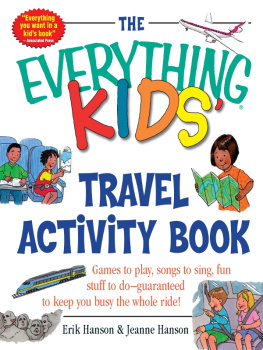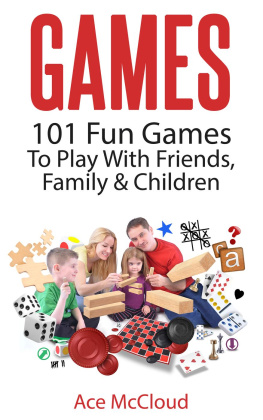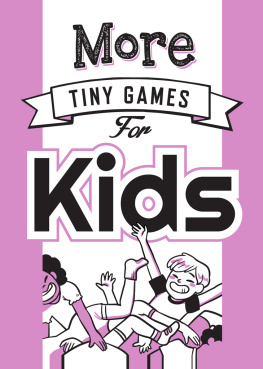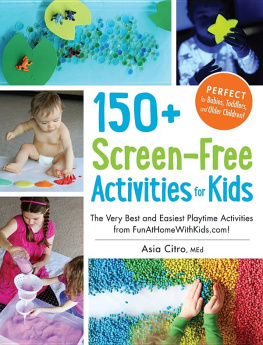UNPLUGGED PLAY
No Batteries. No Plugs. Pure Fun.
BOBBI CONNER
Illustrations by Amy Patacchiola and Kathy Wyatt
Workman Publishing New York
Copyright 2007 by Bobbi Conner
All rights reserved. No portion of this book may be reproducedmechanically, electronically, or by any other means, including photocopyingwithout written permission of the publisher. Published simultaneously in Canada by Thomas Allen & Son Limited.
Library of Congress Cataloging-in-Publication Data is available.
eISBN: 9780761152729
This book references websites that may be of interest to the reader. Every effort has been made to ensure that the information about these websites is correct and up-to-date as of press time.
Cover designed by Paul Gamarello
Photo Credits: Front coverGirl with kitchen pot: Sean Justice/Corbis; Boy playing sack race: Photodisc/Punchstock; Girl with plane: David Katzenstein/Corbis; Hose: Photodisc/Getty Images.
Workman books are available at special discounts when purchased in bulk for premiums and sales promotions as well as for fund-raising or educational use. Special editions or book excerpts can also be created to specification. For details, contact the Special Sales Director at the address below.
Workman Publishing Company, Inc.
225 Varick Street
New York, NY 10014-4381
www.workman.com
NOTE: The games and activities in this book were developed for specific age groups and abilities; however, not all toddlers, preschoolers, or grade-school children have the same capabilities. Please supervise your child carefully and select only games and activities that are appropriate and safe for your individual child.
Dedication
To Billy, Cassidy, Olivia, and Peter for the joy you bring to my life each day.
And to my mother, Charlotte, for giving me a childhood filled with fun and imaginative play.
Acknowledgments
This book is built upon the play experiences of real children who have engaged in all sorts of creative, active play. Let me begin by thanking my own children, Cassidy, Olivia, and Peter, for being such enthusiastic unplugged players during every stage of their childhood. Their exuberant, clever play ideas are woven into each section of this book.
I am deeply indebted to the fabulous game brainstormer and play reviewer (and extraordinary mom) Kiki Walker. Her marvelous can-do attitude made the research phase of this book a delightful experience.
Thank you also to the following children and parents who provided play ideas and tested games:
Lakeshia Alexander; Carol Brown; Tom Daldin; John, Molli, Samantha, and Patricia Dowd; Jonnie, Bud, Andrew, Christian, Joanna, and Mary Grace Furmanchik, Anne, Ed, Claire, and Sam Gutshall; Ann Jenkins; Virginia McCann; Fulton and Ren Millis; Rob, Susan, Teddy, Julia, and Daniel Monyak; Christina, Chris, Jack, Kate, and Lucy Oxford; Liz and Bob Sauntry; Duncan, Lisa, Will, and Catherine Sherer; Els Sincebaugh; Breonna Tiller; Jacob Ufkes; Doug, Jack, George, Harry, and Lucy Walker; and Debbie Willis.
Olivia Conners creative thinking skills and artistic talents helped shape many of the arts and crafts projects in the book.
In my professional life, I have had the great pleasure of interviewing hundreds of wise and compassionate child development specialists about play, friendships, growing, and learning in my twenty-one years as host of The Parents Journal public radio show. I offer a special thanks to these childhood experts, who have generously shared their insight, words of wisdom, and interview quotes in this book. (Julia Vanderelst stayed busy, typing hundreds of hours of program transcripts from The Parents Journal to capture these quotes.) Also, I could not have written this book without the dedication of my radio coworkers: Ellen Pruitt, Bruce Roberts, and Madeleine Thomas.
My first-rate agent (and terrific human being), Jim Levine, found just the right publisher for my book. Nina Graybill wears two hats marvelously wellboth talented writer and outstanding attorneyand her advice and suggestions are much appreciated.
The exceptional team at Workman has made the publishing of this book a wonderful, collaborative experience. In the beginning, Peter Workman gave his enthusiastic yes to the importance of Unplugged Play. Megan Nicolay has been an outstanding editor and a delight to work with, providing creative ideas, careful editing, and great attention to detail. Suzie Bolotin nurtured this book from start to finish, offering a brilliant combination of encouragement, review, and fine editing along the way. The splendid art, illustrations, typesetting, and design provided by Paul Gamarello, Orlando Adiao, Dove Pedlosky, Barbara Peragine, Catherine Leonardo, Amy Patacchiola, and Kathy Wyatt capture the essence of children at play and provide an easy-to-navigate format. Others at Workman I especially wish to thank are Melanie Bennitt, Amy Corley, Amanda Pritzker, Doug Wolff, Haley Pelton, and Savannah Ashour. It has been a great pleasure to work with each and every one of you.
And finally, a word of thanks to my husband, Billy, whose playful spirit enhances my life each day, and who offered just the right mix of encouragement and humor to lighten my routine during long stretches of writing.
PREFACE
Play Matters
WHYAND HOWI WROTE THIS BOOK
Children like to play. And why wouldnt they? Its fun! So it makes sense that the more they play, the more they want to play again. Its a lovely, self-perpetuating cycle that most parents intuitively understand. But what is harder to grasp is the power of play to shape a childs world, particularly a world that is high-tech, fast paced, and plugged in.
And thats why I wrote this book. During my twenty years as host of the nationally syndicated The Parents Journal public radio show, Ive chatted with many of the leaders in the world of child development. Whether it was David Elkind or Penelope Leach, Fred Rogers or Benjamin Spock, they allevery one of themspoke of the significance of play. And now I want to help parents help their children enjoy the wholesome, old-fashioned experience of playing creatively and freely without batteries. I started by collecting and inventing hundreds of games, and then I tested them one by one on different groups of children, ages twelve months to ten years. When the kids rejected a game or an activity, I rejected it too. When a game inspired them to come up with a variation of their own, I appropriated their invention. The result is the more than seven hundred unplugged games that you have here.
But why unplugged, you may ask. Since most of us embrace technology to some extent every daycan you imagine a world without e-mail?it may seem far-fetched to suggest that parents minimize the amount of time their child spends connected to anything with a screen, a plug, or a battery. Besides, its so easy to plunk a kid in front of a TV! But children need to interact with living, breathing human playmates, and not be held captive by the lights, sounds, and images on a screen. They need to run, chase, ride, skip, and jump, and not sit still for prolonged blocks of time. We need only look at the huge rise in childhood obesity to understand how children suffer physically when they remain inactive.
But the toll on kids who rely primarily on electronics for their entertainment goes way beyond some extra pounds. When a child sits in front of a screen, he has no opportunity to connect with the natural world outsidemud, water, sand, stones, leaves, seeds, animals, insects, sunshine, and rain. It might not seem like such a huge loss at the moment when your child is contentedly clicking buttons on the keypad, but there is something essential about a child getting his hands messy. In addition, because electronic games are preprogrammed with finite possible responses, they limit the imagination. A child who draws, paints, builds, and invents experiences a creativity that has no boundaries. By learning that he has the ability to shape his worldeither alone or in the company of othershe gains the self-confidence he needs to grow into a problem-solving, creative adult.









